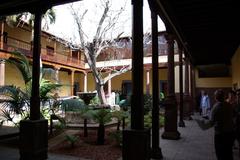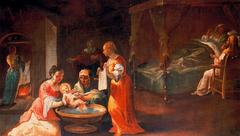
Ex-Convento de San Agustín Visiting Hours, Tickets, and Historical Guide – San Cristóbal de La Laguna
Date: 03/07/2025
Introduction
The Ex-Convento de San Agustín is a landmark of religious, educational, and architectural heritage in San Cristóbal de La Laguna, Tenerife. Established in the early 16th century, it is a testament to the city’s colonial past, Renaissance city planning, and vibrant cultural life. This guide provides an in-depth look at the convent’s history, architectural highlights, visitor information, and its continued role in the community. Whether you are a history enthusiast, architecture lover, or a traveler, this article will help you plan a meaningful visit to one of the Canary Islands’ most treasured historic sites.
Table of Contents
- Historical Overview
- Architectural and Artistic Features
- Visiting Information
- Visitor Tips and FAQs
- Visual Highlights
- Conclusion and Recommendations
- References
Historical Overview
Founding and Augustinian Origins
The Ex-Convento de San Agustín was established shortly after the conquest of Tenerife, with land granted to the Augustinian Order by Alonso Fernández de Lugo in 1506. The initial construction took place between 1527 and 1560, on the site of an earlier hermitage dedicated to San Roque (quehacerentenerife.org). The convent quickly became a center for religious devotion and scholarly pursuits within the newly founded city of La Laguna (webtenerife.com).
Architectural Evolution
The original design reflects a blend of late Gothic and Renaissance elements, with later Baroque influences evident in the church’s bell tower and decorative details. Notable features include two principal cloisters—the Renaissance main cloister and the 18th-century Cloister of the Cypresses—alongside other additions reflecting the convent’s evolving roles (Gobierno de Canarias).
Religious and Educational Significance
Initially dedicated to Nuestra Señora de Gracia, the church was renowned for its three naves and 17th-century Portuguese image of the Virgin of Grace, illustrating the Augustinian Order’s international connections (webtenerife.com). The convent was a burial site for monks and benefactors, and played a pivotal role in religious festivities.
In 1539, the establishment of the Cátedra de Gramática y Latinidad marked the beginning of higher education in the Canary Islands (quehacerentenerife.org). The convent later housed the Universidad Literaria de San Fernando and, from 1846, the Instituto de Segunda Enseñanza de Canarias, educating generations of Canarians including the renowned writer Benito Pérez Galdós (turismo.aytolalaguna.es).
Transformations and Conservation
The 19th century brought secularization, with the building repurposed as military barracks and later as a secondary school. A major fire in 1964 devastated the church, but restoration efforts preserved much of the main convent structure (patrimoniomundial.aytolalaguna.es). Declared a Bien de Interés Cultural in 1983, the Ex-Convento benefits from ongoing conservation to safeguard its heritage (quehacerentenerife.org).
Architectural and Artistic Features
Exterior Elements and Solar Phenomena
The convent’s main facade blends Renaissance symmetry with later Baroque elements. Its orientation aligns with the summer solstice sunset, a deliberate feature reflecting the builders’ knowledge of astronomy (Gobierno de Canarias). Hexagonal buttresses flank the southern entrance, creating a unique solar effect where shadows align precisely with the solstice—a testament to the integration of science, faith, and architecture.
Local volcanic stone, required by municipal regulations, was used throughout, giving the building durability and a distinct Canarian aesthetic (Reisen nach Spanien).
Cloisters and Gardens
The main Renaissance cloister—a two-story arcade with Tuscan columns and wooden elements—is among the most beautiful in the Canary Islands. Its central garden showcases flora from various continents, reflecting the Augustinians’ global connections and botanical interests. The Cloister of the Cypresses, added in the 18th century, and other courtyards provide tranquil spaces for reflection and cultural events (lonelyplanet.com).
Artistic Heritage
Despite losses from the 1964 fire, the convent retains valuable religious paintings and sculptures from the 17th and 18th centuries, now exhibited in galleries and exhibition spaces. Italian-inspired mural paintings and Mudejar-style wooden ceilings are visible in surviving chapels (patrimoniomundial.aytolalaguna.es). The site also features educational exhibits that highlight its legacy as a center for science and learning.
Visiting Information
Opening Hours and Tickets
- General Opening: Tuesday to Sunday, 10:00 AM to 6:00 PM; closed Mondays and holidays. Hours may vary for special events or restoration work—always check the Tenerife tourism website before your visit.
- Tickets: Entry is often free, but donations are welcome to support preservation. Special exhibitions or guided tours may have a nominal fee. Tickets can be reserved onsite or via official tourism platforms.
Accessibility
Most public areas, including the cloister and exhibition rooms, are accessible to visitors with reduced mobility. Some historic upper floors and chapels may have limited access. For assistance, contact the site in advance (turismo.aytolalaguna.es).
Guided Tours and Events
Guided tours in Spanish and English are available and highly recommended for a deeper understanding of the convent’s history and architecture. The Ex-Convento regularly hosts art exhibitions, concerts, and community events within its cloisters (lonelyplanet.com). For bookings, contact the local tourism office or check event listings online.
Getting There and Nearby Attractions
Visitor Tips and FAQs
Tips for Your Visit
- Combine with Other Sites: Plan a walking tour of the historic center, including the convent, cathedral, and local museums.
- Photography: The cloisters and gardens are especially photogenic in the morning and late afternoon, with dramatic light and shadow.
- Respect Restoration Areas: Some sections may be closed for restoration; please observe all signage.
- Local Cuisine: Enjoy traditional Canarian dishes at nearby restaurants such as Guaydil, Maquilla, or Jinete sin Cabeza (Richi Perez).
Frequently Asked Questions (FAQ)
Q: What are the current visiting hours?
A: Tuesday to Sunday, 10:00 AM–6:00 PM (closed Mondays and holidays). Confirm before your visit due to possible schedule changes.
Q: Is there an entrance fee?
A: Entry is generally free. Fees may apply for guided tours or special exhibitions.
Q: Are guided tours available?
A: Yes, in Spanish and English. Book through the tourism office or onsite.
Q: Is the site wheelchair accessible?
A: Most areas are accessible. Contact ahead for assistance if needed.
Q: Can I visit as part of a school or research group?
A: Special arrangements can be made through the local council or cultural institutions.
Q: What other attractions are nearby?
A: The Cathedral of La Laguna, Museo de Historia de Tenerife, and other UNESCO-listed sites are within walking distance.
Visual Highlights
Recommended images (to be included by site managers):
- Cloisters with arcaded galleries and central garden (“Ex-Convento de San Agustín cloisters with Renaissance arcades in San Cristóbal de La Laguna”)
- Ruins of the church interior with remnants of the Mudéjar ceiling (“Ruins of the Ex-Convento de San Agustín church with Mudéjar ceiling remains”)
- Map of the convent’s location within the historic center
Conclusion and Recommendations
The Ex-Convento de San Agustín is an essential destination for anyone interested in the heritage of San Cristóbal de La Laguna and Tenerife. Its layered history—spanning monastic life, the birth of Canarian higher education, and vibrant contemporary cultural events—makes it a living monument to the city’s enduring legacy. For the most rewarding experience, plan your visit in advance, check for guided tours and events, and immerse yourself in the unique blend of history, architecture, and community that the Ex-Convento offers.
Download the Audiala app for guided audio tours and up-to-date event information, and follow us on social media for more insights and inspiration about Tenerife’s cultural treasures.
References and Further Information
- Que Hacer en Tenerife – Ex-Convento de San Agustín
- Gobierno de Canarias – Iglesia y Ex-Convento de San Agustín
- Ayuntamiento de La Laguna – Antiguo Convento de San Agustín
- Guide to Canary Islands – Things To Do in San Cristóbal de La Laguna
- Lonely Planet – Iglesia y Ex-Convento de San Agustín
- Richi Perez – Things To Do in San Cristóbal de La Laguna
- Reisen nach Spanien – Tenerife and San Cristóbal de La Laguna


